
One of the paradoxes of general aviation is trying to make sense of hangar availability. Even though overall flying seems to be down, trying to find a hangar at many airports is an exercise in getting on waiting lists or going through never-ending procedures for approval to build a hangar. At others, hangars stand empty and deteriorating.
We’ve given up trying to understand the dynamics of hangar shortages on airports where there is plenty of open space to build. Nevertheless, we’re going to look at how to go about building a hangar when the stars line up and the opportunity arises.
WHAT TYPE OF AIRPORT?
The degree of flexibility you will have in designing, building, using and eventually disposing of a hangar varies with the type of airport on which it is to be constructed. The owner of a public use airport that accepts federal Airport Improvement Program (AIP) funds agrees to run the airport in a specified fashion as a condition of receiving the money. The conditions are called grant assurances. Those airports have extensive power to regulate terms and conditions of hangar construction (including color) and use as we’ll as the terms of the lease for the ground on which you build the hangar.
Airports that do not accept federal AIP money, usually private airports, can set just about any terms and conditions on hangars that they want. They tend to be far less restrictive than public use airports.
Residential airports are often hybrid creations. While many are private airports, some are public use airports that accept AIP grants and set up “through the fence” agreements for people to buy or lease property adjacent to the airport for hangars (and houses) and taxi their aircraft from their hangars to the runway.
With that as background, it is our suggestion that step one after deciding to build a hangar is to learn all you can about the airport and its friendliness to private hangars. On a public use airport that means going through its Minimum Standards and airport rules and regulations. Are you willing to comply with them? Are any out of date and needing to be changed—and can you do anything about it without driving yourself nuts in the process?
The airport sets rules to protect itself from owners who want to spend the minimum amount possible to toss together structures that will evaporate during the first thunderstorm and are eyesores in the meantime. The FAA gives public use airports substantial leeway in establishing hangar construction requirements. If the requirements seem unreasonable (and you’re a reasonable person), that’s an indication that dealing with airport management will be challenging.
INVESTIGATE
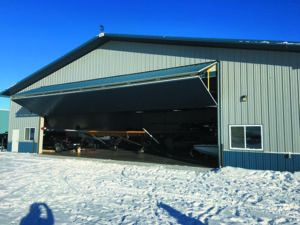
Get to know owners of private hangars and find out what sort of experience they have had. Recognize that aviation is made of Type-A sorts who do not always play we’ll with others. As you learn of problems at the airport, try to figure out whether they are driven by airport management or unhappy hangar owners.
We cannot overemphasize the need to make sure that you will be able to work with airport management. We’ve seen the entire spectrum—this magazine isn’t large enough to hold the stories.
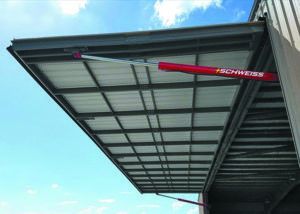
On a private or residential airport, getting to know the other hangar owners and the people who make up the organization that runs the airport is crucial. Make sure you see all of the airport rules and restrictive covenants that affect construction of a hangar, how the hangar may be used and how you can operate your airplane. Don’t go in thinking that rules you don’t like will be ignored by management—you can end up losing your investment in the hangar.
The next step is to sit down with airport management. You’ll need to provide a detailed outline of what you want to do, how much land you’ll need, where you’d like it to be, the size and shape of the hangar and what you want to do with it.
Nothing frustrates airport managers dealing with prospective hangar builders more than a lack of clarity in what the builder wants. They’ve seen too much of the “Uh, I was thinking of a 60 by 60 hangar, but I’d really like to do a 60 by 120 hangar for my own use, but maybe, sometime down the road I’d like to rent out space for other airplanes or for guys to build homebuilts or maybe even a little maintenance shop … “
Once you’ve said what you want to build, you should expect the airport manager to tell you precisely what land is available, the square foot cost to lease the land, the length of the lease you can get, its precise terms and what will be involved in taxiway access.
THE LEASE
Grant Assurance 38 calls for airport land leases for hangar construction to be “long term.” That has been interpreted in a number of ways. Generally, the FAA recognizes that a lease has to be long enough for the hangar owner to get a loan to build the hangar, pay it off and get value from use of the hangar. The FAA provides only loose guidance—it gives the airport owner quite a bit of leeway in defining long term.
We have seen hangar land lease terms for 20 years with an option to renew for 20 years. More often, we see leases for 25 years with five-year renewal options that run the total time to 35-40 years.
We saw one land lease for only five years. It was renewable. However, we think that is far too short to be in compliance with Grant Assurance 38, especially as we also learned that one hangar owner managed to upset the airport power structure and his lease wasn’t renewed after five years.
HOW LONG?
Our opinion on lease term? We think 20 years is too short to allow for financing and return on investment. (The warranty on many pre-engineered hangars is usually longer than that.) We think a combination of an initial lease in the 25-year range with renewals taking it to a maximum of 40 years is about right. That’s based on expected life of a well-constructed building that is probably going to need some refurbishment at 40 years. It allows the initial owner to be able to sell the hangar at a reasonable price based on the amount of time left on the lease.
We have seen indications that the FAA considers a 50-year lease (total time) too long.
We think that an unexpired lease should be transferrable with approval of the airport. In our opinion, such approval should be readily given unless the applicant cannot make a showing of the financial ability to make lease payments and maintain the hangar.
EVICTION
We strongly recommend that a prospective hangar owner not accept a lease that makes it easy for the airport to throw the owner out of the hangar for minor violations of airport rules. We think that the lease should require that if the hangar owner breaches the terms of the lease that the owner has an opportunity to “cure” the breach—fix the problem. If the hangar owner doesn’t come back into compliance, the airport must go through legal proceedings to evict the owner.
In our opinion, a hangar owner who has spent a significant sum of money building a hangar should have the same protection against eviction as a homeowner does with a bank. We’re cynics—we’ve seen what airport politics can become.
REVERSION
Almost all of the airport leases we reviewed have a provision that causes the improvements made on the airport land (the hangar) to revert to airport ownership at the end of the lease term.
We have heard arguments on each side of the reversion issue. Some hangar owners claim that the airport is “taking” their hangar. The reality is that the hangar owner entered into a lease, not a purchase of the land. The hangar owner knew up front that the hangar was going to be without value to the owner at the end of the lease.
The FAA appears to prefer reversion terms in leases, mostly to help airports keep control of old buildings. Who hasn’t seen old airport hangars that are falling down but the airport can’t afford to do anything about it because it can’t afford to sue the hangar owner?
The FAA takes the position that after some period a building has exceeded its useful life in its original condition and, at that point, the airport should get ownership. The airport then has the flexibility to tear it down and lease out the land for something else, or refurbish the hangar and lease it out at a higher rate than it would get for just a land lease. Don’t forget, airports have to make money to stay viable.
READ THE RULES
Check the airport rules regarding what you can and cannot do with your hangar. The sidebar on the opposite page has the FAA’s guidelines.
We’ve seen one instance where the airport rules on hangar usage were not enforced until one hangar owner got sideways with airport management and management used violation of picayune rules to claim the tenant was in breach of the land lease and tried to evict the hangar owner and take over the hangar.
Either make sure you can live with the hangar usage rules or get an agreement approving any nonconforming use you anticipate, in writing, before signing a lease. The airport manager’s word isn’t good enough. The next airport manager may be a by-the-book sort and not care for your nonconforming use.
Review the Airport Layout Plan (ALP). It should show existing facilities on the airport and project future usage. Make sure that your proposed hangar fits in with the ALP and it’s not where the airport plans for another FBO or runway to be in 10 years.
UTILITIES
If it can be done for a reasonable cost, we recommend bringing at least electricity to your hangar. There will probably be airport rules regarding routing and burying lines. An integral part of your decision to build a hangar will be whether you can affordably supply it with electricity.
Water and sewer are nice-to-have items, but rarely inexpensive.
What are the taxes you will face in erecting and owning the hangar? These vary widely across the country, and the existence of property taxes will probably be a given.
Are there zoning regulations? Is there a permitting requirement for construction? What are the associated fees?
On almost all public use airports you’ll need to file an FAA Form 7460-1 at least 45 days prior to construction. The FAA is concerned with structures that could project into protected airspace around runways or block the view of aircraft in movement areas from the tower. It’s usually a formality, but we are aware of times when it meant that the design of the hangar had to be modified. Don’t start building without approval.
THE STRUCTURE
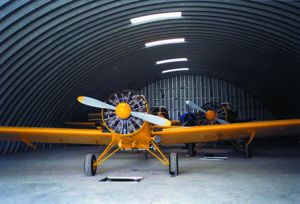
The most common hangar structure is post-and-beam. There are numerous companies offering turnkey pre-engineered box hangars. Pre-fabricated Quonset/Nissen hut-style hangars cost less, but are difficult to insulate and on some, the sloping walls reduce aircraft storage area. There are fabric hangars on the market—we consider them to be temporary structures. There are also “portable” hangars that may meet airport rules and be financially attractive.
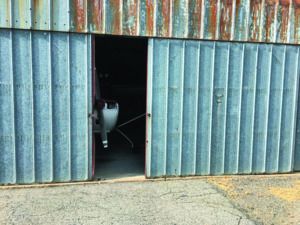
Post-and-beam structures are split into an open-webbed truss with straight columns and a rigid frame. The rigid frame uses tapered frame sidewalls (wider at the top than bottom) and rafters. The open-webbed truss uses straight sidewall columns that are much thinner than the tapered frame sidewalls and truss rafters. The open-webbed truss has a substantially smaller wall width, giving more space inside the hangar and allowing a larger door for a given overall hangar footprint.
IT’S ABOUT THE DOOR
It really is all about the door. We recommend that you buy all of the size, ease of operation and reliability your budget will allow. The three main types in ascending cost are sliding, electric bi-fold and one-piece hydraulic lift.
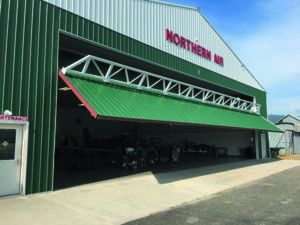
Manual sliding doors have rollers on the top and are routed by a series of metal guides on the floor or have rollers on the bottom on an embedded track and door guides on the top of the opening. A track impedes the smooth rolling of your airplane into and out of the hangar and can overpower small tugs. We blew a tire on our car when we drove over one of the guides on a top-roller sliding hangar door.
We rapidly came to despise manual sliding doors in snow country and any place that the ground may swell or heave causing the doors to be either very difficult or impossible to move. Our three-word recommendation regarding manual sliding hangar doors: Don’t do it.
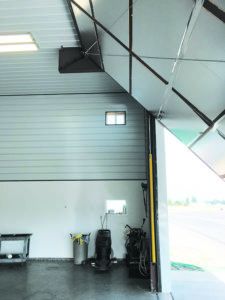
Powered sliding doors are ordinarily only used on very large hangars and are outside the scope of this article.
The most common type of powered hangar door is the electric bi-fold. It is more expensive than a slider but, in our opinion, far more satisfactory in the long run. By definition, it requires electricity to operate. We’re not aware of any owners who rely on a generator to operate their bi-fold doors, but given the frustrations of sliding doors, we wouldn’t be surprised to see it.
An electric bi-fold door is attached either to the header system of the hangar, door truss or door frame. Closed, it latches to the vertical door columns—either automatically or manually. An open bi-fold door forms a wedge that subtracts some three feet from the vertical portion of the door opening so it may require building a taller hangar than needed for other doors.
HYDRAULIC SWING DOORS
Hydraulic swing doors are a single unit that swing upward and are, in our opinion, the top of the line of hangar doors. They do not create a wedge when open so the top of the door is at or near the top of the open space.
When open, the door creates a large shaded area in front of the hangar. The compromise is that because it swings outward, it requires parking the airplane we’ll clear of the door when opening it.
Things to consider when considering any powered door include:
• Gear box and drive system—we’ve seen some where they were incredibly stupidly located so that they partially blocked access
through the human door to the hangar.
• Location of the door control panel—when considering the design, think of trying to find it after entering the hangar in the dark.
• Safety factors in the door as we’ll as its lift system (hydraulics, cables or straps). What happens when something in the lift system wears out? The switch to close the door should automatically stop the door travel when closing if the operator lets go of the switch or stops pushing the button.
• The circuit breaker for the door should be convenient to reach and reset. You will have to reset it at some time. We had a hangar where the circuit breaker was on a wall just below the ceiling—it required climbing a ladder to reset. If we ever get our hands on the person responsible for that design …
• Make sure you see one of the doors installed—and operate it—before you buy.
INSURANCE
While researching this article we found that if you build a hangar on land leased from an airport you will almost certainly be required to insure the hangar and name the airport owner as an additional insured.
The follow-on question we had was whether a hangar owner’s aircraft insurance will cover the hangar as we’ll as the aircraft or if the hangar owner will have to purchase a separate policy for the hangar.
We did not get a consistent answer. We found that a number of aircraft policies also cover the aircraft owner’s hangar for loss if the hangar burns up or liability if someone slips and falls in the hangar. Not all do. Our recommendation is that you check with your insurance broker and read your aircraft policy carefully. That applies especially if you also store your boat or RV in the hangar with your airplane.
If you build a hangar and you let others park their airplanes in it along with yours, your aircraft policy will almost certainly not provide coverage. It may be necessary to buy a commercial hangar policy. Check with your broker.
COST
The rule of thumb for hangar rental prices is that the busier the airport, the more expensive the hangar rent. Rent also goes up for the quality of the hangar, if it has electricity and the type of door installed. We have seen monthly rental rates for T-hangars at small, rural airports as low as $200. At busy, urban airports rates we’ll exceed $1000. During our research we did not find many box-type hangars for rent. If you want the spaciousness and utility of a box hangar, you will probably have to build or buy an existing one.
If you are going to lease land and build a hangar, expect land lease prices to increase as airports get busier. Figure on a minimum of $800 a year at a rural airport and work upward, sharply upward.
To start your building decision computation, we think $50,000 should buy a turnkey, uninsulated 40-foot x 40-foot box hangar with an electric bi-fold door.
CONCLUSION
We believe that hangar ownership is valuable on several levels, including the pure enjoyment it can provide, plus it keeps the aircraft out of the elements.
Because it is on leased land and your ownership has a finite life, we don’t recommend that it be considered an investment. As with avionics upgrades to your airplane, the value of that upgrade is in the usefulness to you—the resale value of the airplane did not increase by the amount of the cost of the upgrade. A hangar you own is valuable in its own right.




